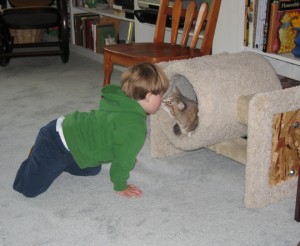 It has long been thought that children in households with pets are healthier physically and emotionally than children without pets in their life. But a report issued by the Rand Corporation just last month claims this is not necessarily true. While they noted a slight increase in the overall health of children living in a home with pets—because they tend to get more exercise than children without pets—researchers do not believe there is a significant difference.
It has long been thought that children in households with pets are healthier physically and emotionally than children without pets in their life. But a report issued by the Rand Corporation just last month claims this is not necessarily true. While they noted a slight increase in the overall health of children living in a home with pets—because they tend to get more exercise than children without pets—researchers do not believe there is a significant difference.
Evidently former studies, stating that pets are beneficial to children’s health and well-being, were conducted among smaller groups of families and there were fewer additional factors considered—such as financial status of the family, ethnicity, etc.
I don’t know about you, but I believe pets presented in  the right light, are essential to the health and well-being of children. And I’ve written articles on the topic for Cat Fancy Magazine, a popular horse magazine, and others. These articles focused on the opportunity pets provide to teach children responsibility and compassion.
the right light, are essential to the health and well-being of children. And I’ve written articles on the topic for Cat Fancy Magazine, a popular horse magazine, and others. These articles focused on the opportunity pets provide to teach children responsibility and compassion.
Every thinking and aware parent knows that they can’t just bring home a pet and expect their small child to take full responsibility for the kitten, puppy, hamster, etc. Children need guidance and instruction and a role model to follow in caring for a critter. And this means that the parents need to hang out with their child and the pet to make sure the animal receives the care it requires. It may mean nagging, at times. But the parent is definitely responsible for teaching the child how to behave around a pet, treat the pet, and to give them age-appropriate responsibilities with regard to caring for the pet.
 While a pet may not be appropriate in every household, I believe that every child should have the opportunity to interact with one or more animals. Some kids are animal magnets. Some just don’t naturally warm up to cats and dogs. Some have learned to fear or dislike animals or they’re simply indifferent where animals are concerned. This is not a typical response, however. I believe it is taught by parents and other caregivers, siblings, relatives with pet phobias and lack of understanding of animals.
While a pet may not be appropriate in every household, I believe that every child should have the opportunity to interact with one or more animals. Some kids are animal magnets. Some just don’t naturally warm up to cats and dogs. Some have learned to fear or dislike animals or they’re simply indifferent where animals are concerned. This is not a typical response, however. I believe it is taught by parents and other caregivers, siblings, relatives with pet phobias and lack of understanding of animals.
What are some ways that you can instill a compassion for and an understanding for animals without necessarily having one in your household? Arrange for the child to interact with a neighbor’s or friend’s quiet, calm, tolerant pet. Volunteer with them at an animal shelter. Visit the zoo or animal shelter often and teach your child about the various animals. Read books and watch movies where animals are portrayed in a positive manner. Share some of the animal videos you enjoy on the Internet with the child—web cams on bird nests in the spring, for example.
Dogs, cats, and horses are often used as therapy for autistic children, slow learners, and emotionally traumatized children. There’s story after story of positive relationships between a child and an animal. Here are a few: https://childmind.org/article/animals-help-children-overcome-challenges/ http://www.sheknows.com/pets-and-animals/articles/2212/kids-and-pets
Now if you want to read the results of Rand’s recent study, here’s the link: https://www.sciencedaily.com/releases/2017/08/170807120516.htm





